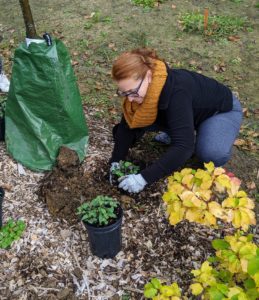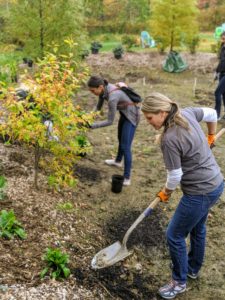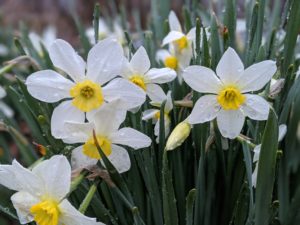The days are getting shorter and summer is coming to an end. It’s time to clean up and put away the garden tools until next spring, right? Not so fast! If we look to Mother Nature for an example, she plants in the fall. When plants are done flowering, they produce seeds. These seeds are scattered through wind, gravity and animals, and land on warm soil. There in the fall, they are ready to continue the life cycle of their species.

According to Tyler’s Community Engagement Director, Julia Lo Ehrhardt, late summer is the best time to “edit” your garden. You can reflect on your beds and determine what worked and what didn’t, and how you’d want your garden to look in the future. Are there bare spots that need to be filled? Maybe there is a gap in bloom times or not enough yellow flowers? By putting in new plants in the fall, you can address these problems while you can still see what needs to be done. Perennials, bulbs, shrubs and trees are prime candidates for fall planting.
There are several advantages to planting in the fall. Plants always suffer some shock when transplanted from a pot to a garden bed, or even from garden to garden. Fall planting is less stressful for plants. The air is cooler, which means the plants will not be losing as much water from their leaves. The soil is still warm, which encourages active root growth. As long as they are planted before the first frost (about November 15 in our area), plants have plenty of time to establish strong root systems. Root growth continues until the average air temperature is about 48 degrees Fahrenheit before the plant goes dormant. By having a strong root system in place by spring, the plant has a head start to grow and flower. Strong root systems that have reached further down also means that the plant can deal with heat stress better next summer by being able to get to more moisture.

Garden pests aren’t as much of a problem in fall as they are in spring. Most pests that could pose a threat to your plants are past their active growth stage and are not looking for food. Plus, rainfall is usually more plentiful in fall, which means less watering for the gardener!
You’ll have more flowers to look forward to as well. Let’s consider the rhododendron as an example. If you decide to purchase rhododendron in the spring, the plants are often in bloom. This is fine if your main concern is the color of the flowers. Instead of trusting the plant tag, you can see if this is the shade of pink you want. However, the trade-off is that you don’t get to enjoy them as long. After a week or two, the blooms are gone until next year. By planting in the fall, you can enjoy watching your plant develop, see the buds swell, and really appreciate the beauty of the blossoms. Isn’t anticipation part of the joy of spring? Plus you’ll have a plant that is better prepared to face the rigors of summer.

Some plants are meant to be planted in fall like spring flowering bulbs. Remember what we said about filling visual gaps? Plant bulbs where you have perennials that flush out late, like ferns or anemones. That way your bulbs will shine in the spring and be kept cool and moist by perennials throughout the summer.
So gather up your garden tools, grab your wheelbarrow and put on your gloves and hat. It’s time to create next year’s landscape magic, and there is no better place to get started than the Tyler Arboretum plant sale! Our focus this year is on year-round interest, so stop by to pick up all the fantastic plants and tools that you’ll need to get your garden ready for next season. There’s no better time than now to get planting so that you can start next season ahead of the game and give yourself something to look forward to through the winter. Don’t worry if you’re not sure where to start! We have an “Ask the Expert” link that allows you to email one of our experienced plant sale team members directly with questions.






